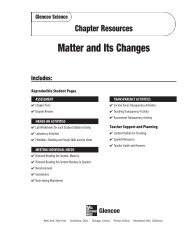Chapter 17: Invertebrate Animals
Chapter 17: Invertebrate Animals
Chapter 17: Invertebrate Animals
You also want an ePaper? Increase the reach of your titles
YUMPU automatically turns print PDFs into web optimized ePapers that Google loves.
Crustaceans Think about where you<br />
can lift the most weight—is it on land or in<br />
water An object seems to weigh less in water because water<br />
pushes up against the pull of gravity. Therefore, a large, heavy<br />
exoskeleton is less limiting in water than on land. The group of<br />
arthropods called crustaceans includes some of the largest<br />
arthropods. However, most crustaceans are small marine animals<br />
that make up the majority of zooplankton. Zooplankton<br />
refers to the tiny, free-floating animals that are food for other<br />
marine animals.<br />
Examples of crustaceans include crabs, crayfish, lobsters,<br />
shrimp, barnacles, water fleas, and sow bugs. Their body structures<br />
vary greatly. Crustaceans usually have two pairs of antennae<br />
attached to the head, three types of chewing appendages, and<br />
five pairs of legs. Many water-living crustaceans also have<br />
appendages called swimmerets on their abdomen. Swimmerets<br />
force water over the feathery gills where carbon dioxide from the<br />
crustacean is exchanged for oxygen in the water.<br />
Echinoderms<br />
Most people know what a starfish is. However, today they<br />
also are known as sea stars. Sea stars belong to a varied group of<br />
animals called echinoderms (ih KI nuh durmz) that have radial<br />
symmetry. Sea stars, brittle stars, sea urchins, sand dollars, and<br />
sea cucumbers are echinoderms. The name echinoderm means<br />
“spiny skin.” As shown in Figure 22, echinoderms have spines of<br />
various lengths that cover the outside of their bodies. Most<br />
echinoderms are supported and protected by an internal skeleton<br />
made up of bonelike plates. Echinoderms have a simple<br />
nervous system but don’t have heads or brains. Some echinoderms<br />
are predators, some are filter feeders, and others feed on<br />
decaying matter.<br />
Observing Sow Bugs<br />
Procedure<br />
1. Place six sow bugs in a<br />
clean, flat container.<br />
2. Put a damp sponge at<br />
one end of the container.<br />
3. Cover the container for<br />
60 s. Remove the cover<br />
and observe where the<br />
sow bugs are. Record<br />
your observations in<br />
your Science Journal.<br />
Analysis<br />
1. What type of habitat do<br />
the sow bugs seem to<br />
prefer<br />
2. Where do you think you<br />
could find sow bugs near<br />
your home<br />
Figure 22 Sun stars have up to<br />
twelve arms instead of five like<br />
many other sea stars. Sea urchins<br />
are covered with protective spines.<br />
Sand dollars have tube feet on<br />
their undersides.<br />
Sand dollar<br />
Sun star<br />
Sea urchin<br />
SECTION 4 Arthropods and Echinoderms 5<strong>17</strong><br />
(l)Alex Kerstitch/Bruce Coleman, Inc., (c)Nancy Sefton, (r)Scott Johnson/<strong>Animals</strong> <strong>Animals</strong>














